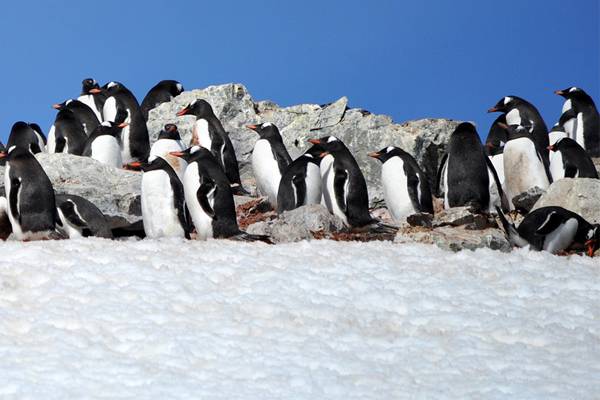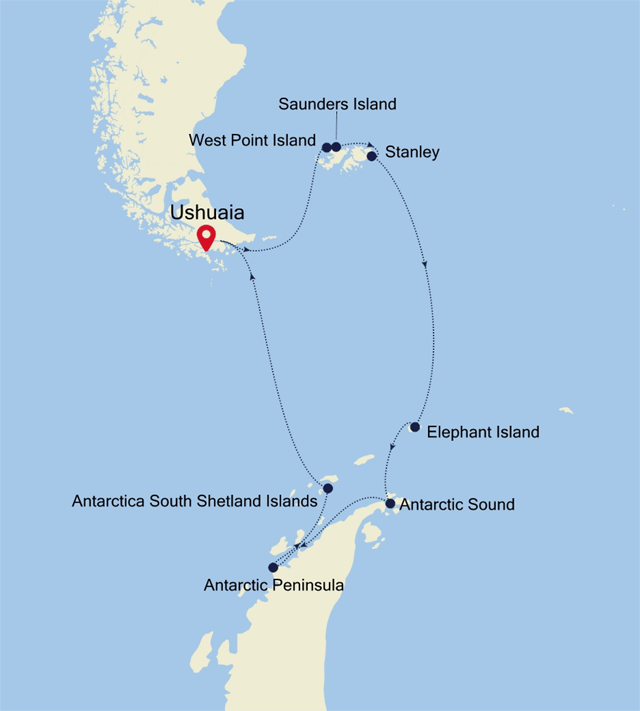HIGHLIGHTS
- Follow
in the footsteps of the great Antarctic explorers and visit sites that
Byrd, Charcot, Fiennes, de Gerlache, Shackleton, and Weddell explored.
- Hike
across New Island and West Point Island to see Black-browed Albatross.
- See
snow-covered mountains, mighty glaciers and spectacular icebergs.
- Encounter
Rockhopper, Gentoo, Macaroni, Adelie, Magellanic and Chinstrap
Penguins, and with some luck also King Penguins.
- Watch
for Commerson’s and Peale dolphins in the Falkland Islands
and Southern right whales close to the Valdes Peninsula.
- Identify
different species of albatross, shearwaters and petrels.
DATES / RATES
Rates are listed per person in USD. Promotional offers are not reflected in the rates below.
|
| Start Date | End Date | Vista Suite | Veranda Suite | Deluxe Veranda Suite | Medallion Suite | Silver Suite | Royal Suite | Grand Suite | Owner's Suite |
|---|
Rates are listed per person in USD. Promotional offers are not reflected in the rates below.
|
| Start Date | End Date | (Starting from)
Vista Suite | (Mid-range)
Silver Suite | (High-end)
Owner's Suite |
|---|
ITINERARY
Day
1 — Ushuaia, Argentina
At
55 degrees latitude south, Ushuaia (pronounced oo-swy-ah) is closer to
the South Pole than to Argentina's northern border with Bolivia. It is
the capital and tourism base for Tierra del Fuego, the island at the
southernmost tip of Argentina. Although its stark physical beauty is
striking, Tierra del Fuego's historical allure is based more on its
mythical past than on rugged reality. The island was inhabited for
6,000 years by Yámana, Haush, Selk'nam, and Alakaluf
Indians. But in 1902 Argentina, eager to populate Patagonia to bolster
its territorial claims, moved to initiate an Ushuaian penal…
Day
2 — At Sea
While
we're at sea, enjoy wine tastings, designer boutiques, language and
dance classes. Take in a matinee movie, check the market or your e-mail
in the Internet Point, slip away with a novel from the library to a
sunny chaise or with a movie to your suite. Or just take in the sun
pool side. The choice is yours.
Day
3 — New Island, Falkland Islands (Malvinas) | West Point
Island
The
remarkable beauty of the remote Falkland Islands can best be seen on
New Island. The westernmost of the inhabited islands of the
archipelago, it is a wildlife and nature reserve, and an environmental
conservation group protects its many birds and animals. There are
rookeries where Rockhopper Penguins and Blue-eyed Shags share the same
nesting area. Black-browed Albatrosses can be seen going about their
daily routines and it is easy to spot Upland Geese. More than 40
species of birds breed on the island. Near the landing site is
‘Barnard’s barn’ — a restored
stone structure going back to…
Located
slightly northwest of West Falkland, West Point Island is used for
sheep farming and nature observations. Peale’s dolphins and
the distinctive black and white markings of the Commerson’s
dolphin can usually be seen in the waters around West Point Island.
Rolling moorland and steep cliffs make for great photographic
opportunities, but the main attraction is the Devil’s Nose, a
cliffside colony of Black-browed Albatrosses nesting side-by-side with
feisty Rockhopper Penguins. Magellanic Penguins and Magellanic
Cormorants can also be found on the island.
Day
4 — Stanley
Tiny
Stanley, capital of the Falklands, seems in many ways like a British
village fallen out of the sky. Many homes are painted in bright colors,
adding visual appeal to this distant outpost. Not far offshore, the
wreck of the Lady Elizabeth, is one of the many vessels remaining as a
silent testimonial to the region's frequent harsh weather conditions.
The islands, also known by their Spanish name of Islas Malvinas, are
home to arguably more tuxedo-clad inhabitants of the penguin variety
than human residents. Various species, such as Gentoo, Magellanic and
the more elusive King penguins,…
Day
5 — At Sea
Day
6 — Elephant Island, Antarctica
Awesome
glaciers flecked with pink algae can be seen approaching Elephant
Island — so named either for its elephant-like appearance or
for sightings of elephant seals here. Elephant Island is home to
several Chinstrap Penguin rookeries, as well as 2,000-year-old moss
colonies. Weddell seals and Macaroni Penguins can also be spotted. In
1916, when Ernest Shackleton’s ship Endurance was crushed in
pack ice in the Weddell Sea, the crew was stranded here for more than 4
months finding shelter under two upturned lifeboats on the spit of land
Shackleton’s men named ‘Point Wild’. The
bust of the…
Day
7 — Antarctic Sound
The
Antarctic Sound is a stretch of water named after the first ship to
have passed through this body of water from the Bransfield Strait to
the Weddell Sea in 1902. The Antarctic eventually sank and crew and
scientists had to spend quite some time in this area before they could
be rescued. Sites that have to do with this story - like Hope Bay or
Paulet Island - are sometimes visited. At Paulet, Hope Bay and Brown
Bluff Adelie and Gentoo Penguins breed, as do Kelp Gulls and Cape
Petrels, Snow Petrels and Skuas. The Sound’s main attractions
are the spectacular tabular icebergs that come from…
Days
8 to 12 — Antarctica Peninsula
Remote
and otherworldly, Antarctica is irresistible for its spectacular
iceberg sculptures and calving glaciers, and for the possibility of
up-close encounters with marine mammals and the iconic penguins. The
Antarctic Peninsula – the main peninsula closest to South
America – has a human history of almost 200 years, with
explorers, sealers, whalers, and scientists who have come to work, and
eventually intrepid visitors coming to enjoy this pristine and remote
wilderness. It is a region of protected bays, unscaled snow-capped
mountains, vast glaciers and a few places where whalers or
scientists…
Day
13 — Antarctica South Shetland Islands
Some
480 mi. (770 km) south of Cape Horn, the South Shetland Islands are
usually the first land seen in Antarctica. Separated from the Antarctic
Peninsula by the Bransfield Strait, nine major islands make up the
group. The region was the first to be exploited by sealers in the early
19th century, and because of its proximity to South America, it still
is the most visited by scientists and tourists. Chinstrap, Adelie,
Gentoo and Macaroni Penguins all breed here. In addition, because it is
the warmest part of the continent, large moss beds as well as orange,
black, grey and green…
Days
14 & 15 — Drake Passage
The
Drake Passage has a notorious reputation for its turbulent seas due to
the westerly winds and the funneling effect of the passage. The
Antarctic Convergence, a natural boundary where cold polar water flows
northward and warmer equatorial water moves southward, is within the
Drake Passage. When these two currents meet, nutrients are pushed to
the surface, often attracting a multitude of seabirds and whales.
Black-browed Albatross, Sooty Shearwaters and White-chinned Petrels
glide in the air currents alongside and in the wake of the ship.
Day
16 — Ushuaia, Argentina
 (Click image to view Ship details)
(Click image to view Ship details)
WHAT'S INCLUDED
- Fares
include charter air and cruise only. International Air is NOT
included.
- There
is no Twinshare rate available on this ship and single supplement is
1.75x the Twin Price listed above in Vista & Veranda Suites and
2x the Twin Price listed above for all other Suites.
- Complimentary
kayaking depending on weather and ice conditions. Available on a
first-come basis prior to each kayaking departure.
- All
trips subject to possible fuel surcharge.




